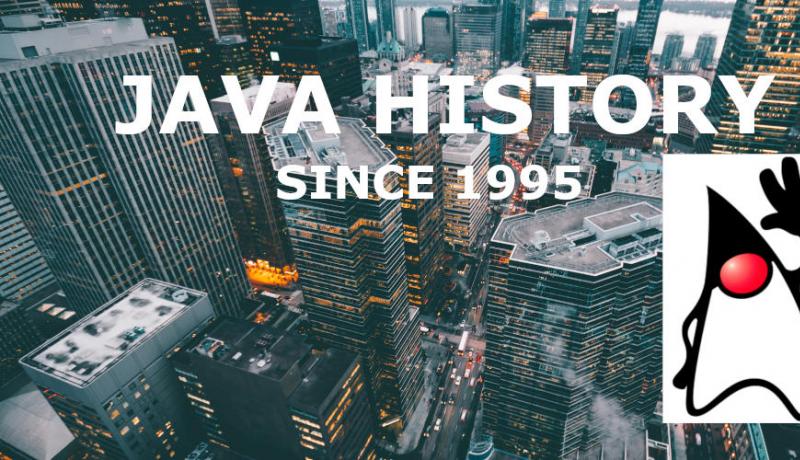
Java is a high-level programming language which is based on C and C++ programming languages. Syntax of Core Java has been adopted from C and C++ languages. Go through tutorials on C before proceeding to Java Tutorials if you do not have basic knowledge about C.
Java Invention History or Evolution
Java was invented by James Gosling along with his colleagues Mike Sheridan and Patrick Naughton. The original name for Java programming language is OAK, a tree outside of the office of James Gosling. Java got its name from an Island Java which is part of Indonesia. SUN MicroSystems is the office where Java was developed and invented. Java evolved as a goto programming language for any job seeker.
Story
Java 1.0 was released to the public in the year 1996 though its initial developer version was completed in 1995 itself. It took 4 years to get to the Java 1.0 version from scratch.
Java was developed with an intention of operating various electronic equipment like Set Top Boxes, Televisions (TV)& and other embedded systems. But surprisingly Java became famous with the advent of the World Wide Web. World Wide Web is simply known as the Internet.
People started using the Internet on various computer systems with different Hardware and Operating Systems. So there was a necessity to develop software that works platform independent. Also security was a very big concern as EXE files easily catch and transmit Viruses and Trojans. Java language came to rescue overcoming these platform dependence and security concerns.
Theory
Java is an Object Oriented Language with Packages and Modules to manage very big projects easily. A Java program is converted into a BYTE CODE file called CLASS file with a file name extension of .CLASS. Java source files are named with a file extension of .JAVA.
To offer Platform Independence, a Java Container called JVM (Java Virtual Machine) is implemented for each type of Machine. You can run the Java Class file containing the byte code on any machine. You get the same output and behaviour on all machines.
Byte code is interpreted on line by line basis or block by block basis to show output. So a Just In Time Compiler (JIT Compiler) was introduced to turn chunks of byte code to EXE. This gives Java Code a high performance.
Java Applet, a special type of java program which has the ability to run inside a browser attracted millions of users and developers to create Applet based websites that can Show Server Data and Collect Inputs from users. The applet is one of the main reasons behind huge initial success of Java language.
Oracle acquired Sun MicroSystems in 2010. So Java is now maintained by Oracle company itself.
Types of Java Software Distributions
Broadly there are 3 types of Java software distributions available.
- Java SE (Java Standard Edition) - GUI application, Networking
- Java EE (Java Enterprise Edition) - Servlets and JSP for web development
- Java ME (Java Micro Edition) - For less powerful devices like PDAs, Printers and Embedded Systems
Java Product Version Numbers
Any Java Version staring with number 1. (ONE POINT) is called Internal Version number and the other version number is called Product Version Number.
| NO | Internal Version | Product Version |
|---|---|---|
| 1. | Java 1.0 | J2SE 1 |
| 2. | Java 1.2 | J2SE 2 |
| 3. | Java 1.3 | J2SE 3 |
| 4. | Java 1.4 | J2SE 4 |
| 5. | Java 1.5 | J2SE 5 |
| 6. | Java 1.6 | Java SE 6 |
| 7. | Java 1.7 | Java SE 7 |
| 8. | Java 1.8 | Java SE 8 |
| 9. | Java 1.9 | Java SE 9 |
| 10. | Java 1.10 | Java SE 10 |
| 11. | Java 1.11 | Java SE 11 |
| 12. | Java 1.12 | Java SE 12 |
Java SE Version Release History or Roadmap
Starting form Java 1.6 or Java 6, J2SE (Java 2 Standard Edition) is called as Java SE. At present Java SE 8 and Java SE 11 versions provide Long Term Support for bugs and security patches.
| Version | Release Date | Support Until | Extended Support |
| 6 | Dec-06 | Dec-15 | Dec-18 |
| 7 | Jul-11 | Jul-19 | Jul-22 |
| 8** | Mar-14 | Mar-22 | Mar-25 |
| 9 (non‑LTS) | Sep-17 | Mar-18 | Not Available |
| 10 (non‑LTS) | Mar-18 | Sep-18 | Not Available |
| 11 (LTS) | Sep-18 | Sep-23 | Sep-26 |
| 12 (non‑LTS) | Mar-19 | Sep-19 | Not Available |
| 13 (non‑LTS) | September 2019*** | Mar-20 | Not Available |
Uses of Java
At present Java language is used in the following areas. There are many beyond mentioning here.
1. Banking Websites or Servers
2. Mission Control Projects
3. Card Swiping Machines
4. Vending Machines
5. Android Operating System
6. Standard PC Applications with a GUI (Graphical User Interface)
7. Distributed Computing
8. Game Development
Getting Ready for Hands on Java
Follow the below steps to write and run your first Java Program.
- Install JAVA on your machine or PC
- Setup a Java Path or Java Home under Environment Variables
- Download a good Text Editor or IDE
- Run the program and see Output
Follow the Last Minute Java Tutorial on Setting Up Tools required to Run Java Programs on your PC.
